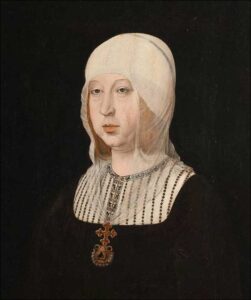The four ships bearing 550 Taíno captives that Columbus dispatched from Isabela on February 24, 1495 (see posts of February 1 and 25) arrived at Cádiz, Spain, on April 7, 1495.
As depicted in Columbus and Caonabó, the ships had labored two weeks skirting east from Isabela along “Española’s” coast, bucking headwinds, merely to attain Boriquén (Puerto Rico), where they veered northeast, encountering increasingly colder weather and inclement seas, arriving the Portuguese island Madeira in late March. By then, most of the 550 had grown severely ill. The Italian Michele da Cuneo—familiar with Genoese slave trading in the Mediterranean and Africa—was returning home on the fleet and perceived that the “Indians” were unaccustomed to the cold winter weather. Whether it was brutal stowage conditions or treatment, European diseases transmitted by the ships’ crews or rats or introduced on a layover at Madeira, and/or the winter climate, some 200 Taínos perished—and their bodies were thrown overboard—before anchoring in Cádiz.
Queen Isabella and King Ferdinand were in Madrid. On April 12, 1495, they received word of the fleet’s arrival and the survivors, and they promptly dispatched a messenger to Bishop Fonseca directing that he sell the Indians as slaves as best he could. But they partially changed their minds over the next four days.
On April 16 (528 years ago), they sent Fonseca revised orders, instructing that they wanted learned men, theologians, and lawyers to advise if, in good conscience, they could sell the Indians as slaves. Fonseca could conduct the crown’s sale on a contingent basis while the determination was made, withholding from Columbus the 10 percent of sale proceeds due him under his entitlements. The Indians would be manumitted, and all sale proceeds returned, if enslavement was determined unlawful. The sovereigns took no action to proscribe the enslavements by Columbus and his men of the other Taínos captured on Española (see post of February 1).
Also portrayed in Columbus and Caonabó, in 1496 Isabella and Ferdinand decided that Indians forcefully resisting their conquest could be enslaved as “war captives.” It wasn’t until 1500—to be depicted in the next sequel—that the sovereigns determined that non-resisting Indians whom Columbus had awarded as slaves to Spaniards returning from Española to Spain in 1498 and 1499 couldn’t be enslaved and ordered the manumission of those then surviving.
In researching the sequel, I haven’t yet found a historic image of a Taíno or Taínos living in Spain from 1495–1500. The portrait is of Isabella, by Juan de Flandes, ca. 1500–1504, within the collection of Madrid’s Royal Palace.

